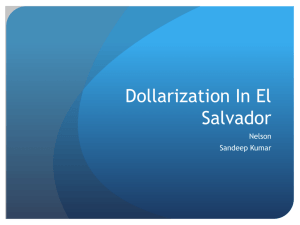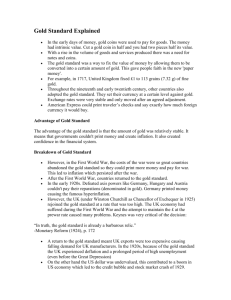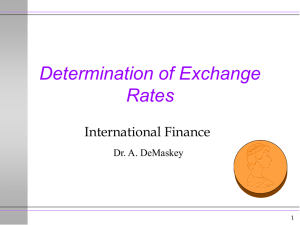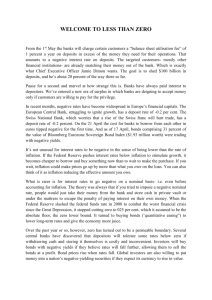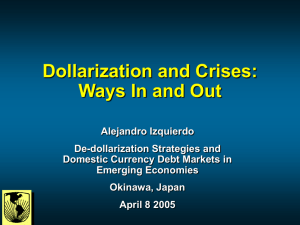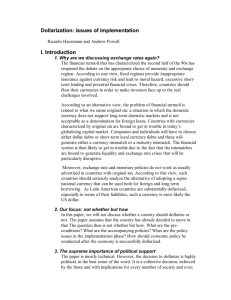Regional Inflation and Financial Dollarization
advertisement
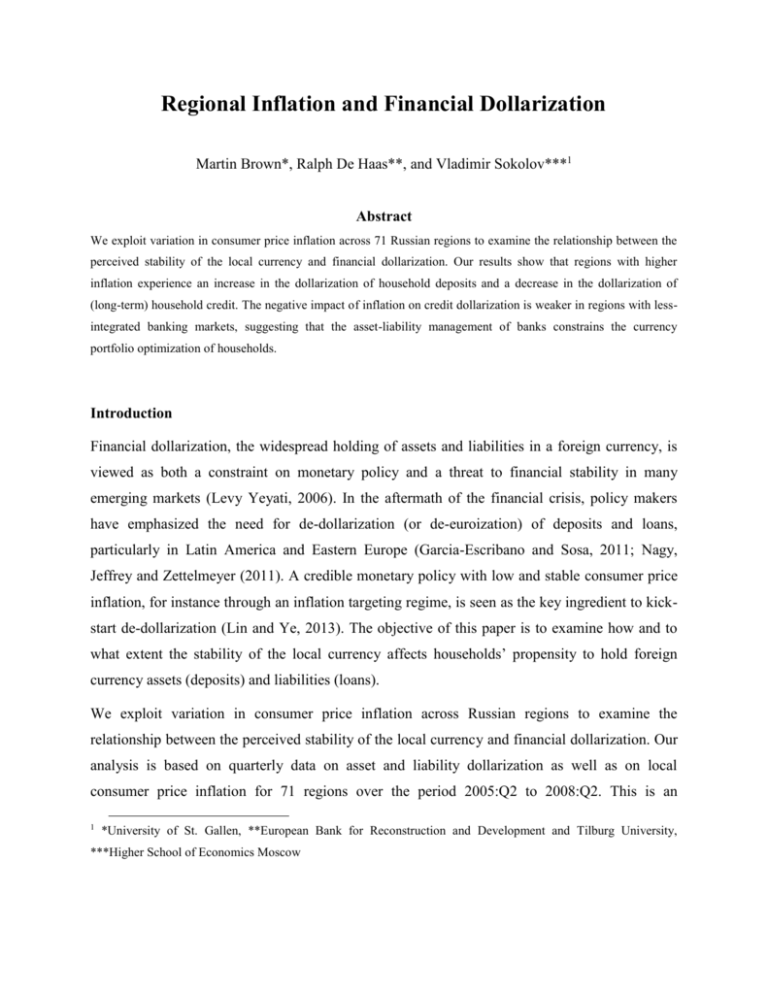
Regional Inflation and Financial Dollarization Martin Brown*, Ralph De Haas**, and Vladimir Sokolov***1 Abstract We exploit variation in consumer price inflation across 71 Russian regions to examine the relationship between the perceived stability of the local currency and financial dollarization. Our results show that regions with higher inflation experience an increase in the dollarization of household deposits and a decrease in the dollarization of (long-term) household credit. The negative impact of inflation on credit dollarization is weaker in regions with lessintegrated banking markets, suggesting that the asset-liability management of banks constrains the currency portfolio optimization of households. Introduction Financial dollarization, the widespread holding of assets and liabilities in a foreign currency, is viewed as both a constraint on monetary policy and a threat to financial stability in many emerging markets (Levy Yeyati, 2006). In the aftermath of the financial crisis, policy makers have emphasized the need for de-dollarization (or de-euroization) of deposits and loans, particularly in Latin America and Eastern Europe (Garcia-Escribano and Sosa, 2011; Nagy, Jeffrey and Zettelmeyer (2011). A credible monetary policy with low and stable consumer price inflation, for instance through an inflation targeting regime, is seen as the key ingredient to kickstart de-dollarization (Lin and Ye, 2013). The objective of this paper is to examine how and to what extent the stability of the local currency affects households’ propensity to hold foreign currency assets (deposits) and liabilities (loans). We exploit variation in consumer price inflation across Russian regions to examine the relationship between the perceived stability of the local currency and financial dollarization. Our analysis is based on quarterly data on asset and liability dollarization as well as on local consumer price inflation for 71 regions over the period 2005:Q2 to 2008:Q2. This is an 1 *University of St. Gallen, **European Bank for Reconstruction and Development and Tilburg University, ***Higher School of Economics Moscow interesting period to analyze as exogenous factors, in particular food and oil price spikes, caused substantial cross-regional and time variation in Russian inflation. Moreover, a year before the start of our sample period Russia introduced a comprehensive deposit insurance scheme which led to a rapid increase in household deposits. The scheme significantly reduced households’ sensitivity to bank-specific risk (Karas et al., 2013), potentially giving further prominence to monetary risks in households’ deposit allocation decisions. Our within-country data allow us to tackle two major shortcomings of previous studies that rely on cross-country data. First, unobserved heterogeneity in economic policies and institutions may cloud the cross-country relationship between monetary conditions and dollarization. We alleviate this concern by examining cross-regional variation within a country with a common macroeconomic policy and institutional framework. Second, cross-country studies cannot disentangle the impact of inflation on dollarization from that of (correlated) changes in exchange rates. Given that exchange rate movements are uniform over all regions within the currency union of the Russian Federation we can isolate the impact of inflation on financial dollarization. We show that regions with high inflation experience higher deposit dollarization and lower dollarization of (long-term) household credit. The impact of inflation on credit dollarization is weaker in regions which are financially less integrated with the rest of the Russian federation, i.e. regions with a higher share of local banks or local bank branches and regions where banks are more reliant on local funding. In such regions the negative impact of inflation on households’ demand for foreign currency loans is partially offset by banks’ efforts to locally intermediate the increased supply of foreign currency deposits. In contrast, in regions with more nation-wide and non-locally funded banks, an inflation-driven influx of foreign currency deposits can be easily distributed to other regions, reducing the need to offload them locally. Such integrated banking markets therefore allow households to respond to inflation shocks by adjusting both their assets and liabilities whereas in less-integrated banking markets the asset-liability management of banks limits the currency portfolio optimization of households. Our results provide partial support for the portfolio theory of financial dollarization (Ize and Levy Yeyati, 2003). This theory argues that the currency composition of assets and liabilities of risk-averse households is determined by real interest rate differentials as well as the volatility of inflation and of the real exchange rate. In line with the theory we find that higher inflation and thus lower (expected) real interest rate differentials are associated with more (less) foreign currency deposits (loans). We find some evidence that variation in inflation volatility across regions impacts on foreign currency deposits, but not on foreign currency loans. Our contribution to the literature is threefold. First, we complement cross-country studies which examine the relation between domestic monetary conditions and financial dollarization. Examining aggregate data for 46 countries for the years 1990-95 Ize and Levy Yeyati (2003) find that the share of foreign currency deposits is positively related to inflation volatility and negatively to exchange rate volatility. De Nicolό et al. (2005) examine a sample of 100 countries for the period 1990-2001 and confirm the impact of inflation and exchange rate volatility on aggregate deposit dollarization. They also find that higher inflation levels are associated with more dollarization. More recently, Lin and Ye (2013) document that emerging market countries which adopt inflation targeting regimes experience a decline in dollarization compared to a matched sample of non-inflation targeters. Specifically focused on the transition economies of emerging Europe, Luca and Petrova (2008) find that aggregate shares of foreign currency loans are positively related to interest rate differentials and inflation volatility, while they are negatively related to exchange rate volatility. These results are confirmed by Basso et al. (2010) who examine aggregate credit and deposit dollarization for 24 transition countries for the period 2000-06. Second, we provide new insights into how inflation impacts financial intermediation. At the country level, Boyd et al. (2001) document a negative relationship between inflation -once it surpasses a certain threshold- and banking development. Lower real returns exacerbate credit market frictions, increase credit rationing, and limit the depth of the banking sector. De Nicolό et al. (2005), also at the country level, show that deposit dollarization moderates this adverse effect of inflation as dollarization allows households to keep deposits onshore when they face high inflation. We document how inflation affects the interaction of the demand for and supply of foreign currency funds between banks and households. In particular, we show how the impact of inflation on asset and liability dollarization depends on the (interregional) integration of the banking sector. Third, our analysis contributes to the growing literature on regional inflation disparities within currency unions. Beck et al. (2009) compare the size and persistence of regional inflation differentials in the euro-zone and the U.S. and show that such differentials are larger and more persistent in the euro-zone. In both currency unions regional inflation differences are related to structural characteristics of non-labor factor markets rather than labor market frictions or growth dynamics. Nagayasu (2011) and Vaone and Ascari (2012) confirm the persistence of regional inflation differences for Japan and Italy, respectively. We add to this literature by documenting how regional inflation variation may lead to the differential use of the common currency by households.
